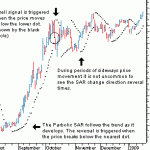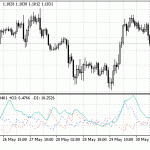How Accumulation & Distribution is Calculated in Stock Market ? To calculate Williams' Accumulation/Distribution indicator, first work out the True Range High ("TRH" - the higher of yesterday's close or todays high) and True Range Low ("TRL" - the lower of yesterdays close or todays low). Williams' Accumulation/Distribution is a cumulative total of "X" … [Read more...]
Accumulation/Distribution -Technical Indicator
Overview Accumulation/Distribution Technical Indicator is determined by the changes in price and volume. The volume acts as a weighting coefficient at the change of price — the higher the coefficient (the volume) is, the greater the contribution of the price change (for this period of time) will be in the value of the indicator. In fact, this indicator is a variant of the … [Read more...]
Parabolic SAR : technical indicator
The parabolic SAR is a technical indicator that is used by many traders to determine the direction of an asset's momentum and the point in time when this momentum has a higher-than-normal probability of switching directions. Sometimes known as the "stop and reversal system", the parabolic SAR was developed by the famous technician Welles Wilder, creator of the relative strength … [Read more...]
Average True Range, ATR
Average True Range or ATR is one popular volatility indicator which can be used by traders of all kinds. It was introduced by J. Welles Wilder in 1978 in his book “New Concepts in Technical Trading Systems”. Although the indicator was developed for commodity futures market, it can be used to trade all financial instruments including stocks and forex currencies.ATR. It is a … [Read more...]
Average Directional Movement Index Technical Indicator (ADX)
Average Directional Movement Index Technical Indicator (ADX) helps to determine if there is a price trend. It was developed and described in detail by Welles Wilder in his book "New concepts in technical trading systems". However, the main purpose of the ADX is to determine whether a stock, future, or currency pair is trending or is in a trading range. Determining which mode a … [Read more...]



